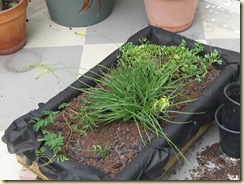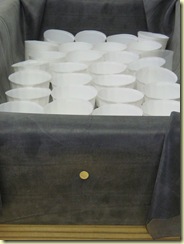On August 8th we planted the first of what we hope will be a series of test strips experimenting with different recipes to determine the best plants, planting media, planting methods and maintenance activities for green roofs in South Florida. 
We are not testing the layering system, waterproofing etc. We are using the easiest construction methods and least expensive materials for the trays and layering system because of budget constraints. The trays are made of pressure treated pine. (cost not weight consideration) The tray is lined with pond liner. A layer of “cups” approximately 2" deep are laid out on the pond liner to mimic commercial drainage systems that get water out of the planting media yet store it for future use. We made this layer out of recycled soda cups. This layer is protected by a filter fabric. The planting media goes on top of this.
The layering system loosely resembles what has been developed by others, commercial green roof providers and the system designed by John Szerdi at the Eco-Centre in Lake Worth.
We are planning to start with two test strips and would like to add more as time and money allow. Only one has been installed so far.
These are the parameters of the test:
Two trays 30” x 30”
One tray will have a 3” planting media depth.
One tray will have an 8” planting media depth
We will plant a mixture of plants in both trays
The 3” tray will have spreading ground covers: Bulbine, Mimosa Strigulosa, Perennial Peanut
The 8” tray will have a mixture of grasses: Wiregrass, Equisetum, Muhlie Grass
Some wildflower seeds will be mixed in with the grasses, just to see what happens: Greeneyes, Gallardia, Coreopsis. These were recommended by the Florida Wildflower Coop.
Both trays will have the same planting media:
50% black lava rock mixed with 50% Canadian peat topped with 1” shredded eucalyptus mulch.
We will ensure that the strips get water, at a minimum, once every three days through an establishment period of one month. After that month, the strips will only be watered if there is less than 1” of rain over a period of 10 days.
We will take pictures of the plants once a month and post them on the blog.
After three years, we will pull the plants to examine their root mass.
These are our assumptions:
Soil mix: We wanted to develop a mix that would be light, drain well and have a little bit of organic material. The lighter colored mulch on top will keep the planting media cooler and retail some water. The black lava rock will have a better ph than red lava rock.
Plant choices were made from our experiences with plants in South Florida. We wanted to use plants that could take very wet or dry conditions in case the tray became flooded over a period of South Florida rainy days. We feel that a mixture of plants is better than a mono culture. Our plant selections are not all native but are selected because we have found that they are very tough and adapt to wet or dry conditions.
We used “trays” for several reasons. We did not have a location to do a full out extensive green roof directly on the roof membrane. Many people feel that trays won’t work in South Florida because they’ll blow off in a hurricane. There are two ways that wind can be approached. The first is to make the “planters” weighty enough to resist hurricane force winds as John Szerdi did at the Eco-Centre. The second is to secure lighter trays to the roof securely enough to resist uplift. We developed one detail for this with Botkins and Parssi for a penthouse garden in Palm Beach and have some alternative attachments that we would like to test in the future. For this project we plan just to put the tray on the roof and remove them when necessary.
Another reason I wanted to experiment with trays is because I’m concerned about what will happen when plant roots make an extensive roof “root bound” over a period of time. Since plants don’t go dormant in South Florida, will the roots take over within 5-10 years? Would the whole roof have to be replanted over a period of time? Or would it be easier to switch trays out? Or, are there plants that wouldn’t develop much of a root system and still survive?
This is our hypothesis:
The plants we have picked are survivors.
After three years, the roots the tray will be ‘root bound’ to a point that it would jeopardize plant health in the following year. The implication of this would be that it would be best to use trays that can be switched out or a plan to replant the roof after 3-4 years.
Potential future test strips:
Dune plants – will they be able to take inundation of several rainy days?
Lighter colored lava rock no mulch – determine weight savings, does ph matter?
Mono cultures (all one type of plant)
Parallel trays that aren’t disassembled after 3 years to see how much longer the plants survive.
Do you have any other ideas?
Please let us know what you think of our assumptions and the way we have set the test up.
Sprout!



No comments:
Post a Comment